An Ornithopod-Dominated Tracksite from the Lower Cretaceous Jiaguan Formation (Barremian-Albian) of Qijiang, South-Central China: New Discoveries, Ichnotaxonomy, Preservation and Palaeoecology
- PMID: 26492525
- PMCID: PMC4619635
- DOI: 10.1371/journal.pone.0141059
An Ornithopod-Dominated Tracksite from the Lower Cretaceous Jiaguan Formation (Barremian-Albian) of Qijiang, South-Central China: New Discoveries, Ichnotaxonomy, Preservation and Palaeoecology
Abstract
The historically-famous Lotus Fortress site, a deep 1.5-3.0-meter-high, 200-meter-long horizonal notch high up in near-vertical sandstone cliffs comprising the Cretaceous Jiaguan Formation, has been known since the 13th Century as an impregnable defensive position. The site is also extraordinary for having multiple tetrapod track-bearing levels, of which the lower two form the floor of part of the notch, and yield very well preserved asseamblages of ornithopod, bird (avian theropod) and pterosaur tracks. Trackway counts indicate that ornithopods dominate (69%) accounting for at least 165 trackmakers, followed by bird (18%), sauropod (10%), and pterosaur (3%). Previous studies designated Lotus Fortress as the type locality of Caririchnium lotus and Wupus agilis both of which are recognized here as valid ichnotaxa. On the basis of multiple parallel trackways both are interpreted as representing the trackways of gregarious species. C. lotus is redescribed here in detail and interpreted to indicate two age cohorts representing subadults that were sometimes bipedal and larger quadrupedal adults. Two other previously described dinosaurian ichnospecies, are here reinterpreted as underprints and considered nomina dubia. Like a growing number of significant tetrapod tracksites in China the Lotus Fortress site reveals new information about the composition of tetrapod faunas from formations in which the skeletal record is sparse. In particular, the site shows the relatively high abundance of Caririchium in a region where saurischian ichnofaunas are often dominant. It is also the only site known to have yielded Wupus agilis. In combination with information from other tracksites from the Jiaguan formation and other Cretaceous formations in the region, the track record is proving increasingly impotant as a major source of information on the vertebrate faunas of the region. The Lotus Fortress site has been developed as a spectacular, geologically-, paleontologically- and a culturally-significant destination within Qijiang National Geological Park.
Conflict of interest statement
Figures
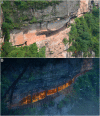

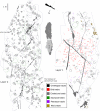
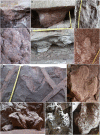

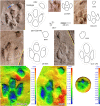
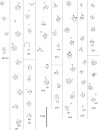
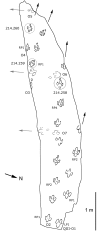
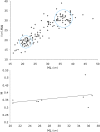




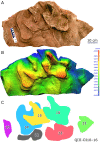



References
-
- Zhen S, Li J, Zhang B. Dinosaur and bird footprints from the Lower Cretaceous of Emei County, Sichuan, China. Mem. Beijing Nat Hist Mus. 1994; 54: 105–120.
-
- Xing LD, Wang FP, Pan SG, Chen W. The Discovery of Dinosaur Footprints from the Middle Cretaceous Jiaguan Formation of Qijiang County, Chongqing City. Acta Geol Sin Chin Ed. 2007; 81: 1591–1602.
-
- Lu TQ, Zhang XL, Chen L. Dinosaur tracks in vertical sections from the Upper Cretaceous Jiaguan Formation of Emei, Sichuan Province. Acta Pal Sin. 2013; 52:518–525.
-
- Xing LD, Buckley LG, McCrea RT, Lockley MG, Zhang JP, Piñuela L, et al. Reanalysis of Wupus agilis (Early Cretaceous) of Chongqing, China as a large avian trace: differentiating between large bird and small theropod tracks. PLoS ONE 10(5): e0124039 doi: 10.1371/journal.pone.0124039 - DOI - PMC - PubMed
-
- Xing LD, Bell PR, Harris JD, Currie PJ. An unusual, three–dimensionally preserved, large hadrosauriform pes track from “mid”–Cretaceous Jiaguan Formation of Chongqing, China. Acta Geol Sin Engl Ed. 2012; 86: 304–312.
Publication types
MeSH terms
LinkOut - more resources
Full Text Sources
Other Literature Sources

